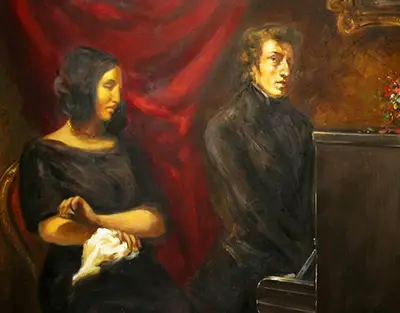 Buy Art Prints Now
Buy Art Prints Nowfrom Amazon
* As an Amazon Associate, and partner with Google Adsense and Ezoic, I earn from qualifying purchases.
The painting displayed here is a representation of an original Delacroix painting which was later separated into two. It helps us to understand the layout of the original double portrait.
The cropped version of Frédéric Chopin is discussed in a separate page, but here we find it as part of an overall painting. The musician is placed on the right hand side besides a piano, whilst George Sand can be found on the opposing side. Her cropped image can now be found at the Ordrupgaard Museum in Copenhagen. It is believed that the original, larger piece was worked on in 1838 but because it was never completed, the decision was made to remove the two figures and present them as two different portraits. The Chopin section removed is 38cm wide and 46cm tall and can be found at the Louvre. Delacroix would always work in larger sizes than this for single portraits when planning that from the start, but this was just intended as part of a larger piece.
George Sand is actually sewing within this painting, which may be hard to make out without seeing the original item in its new location. She was a highly respected French novelist, memoirist, and Socialist with a strong and opinionated character. She was also stunningly beautiful and would have been an ideal choice for Delacroix to feature here. In this artwork she plays assistant to Chopin who dominates the piece, but she was no shrinking violet in real life. At a time when society was not fair to most women, she needed to demonstrate her strength of character in order to make headway in the world. Her birth name was actually Amantine Lucile Aurore Dupin, but she used the pen name of George Sand in order to benefit her publications.
The painting displayed here is an attempt to help us understand how the original looked before it was cut up, but some drawings now found at the Louvre have suggested that the two figures might actually have been positioned much closer to each other than found here. According to research completed on the female figure, she actually liked to sew whilst listening to music, making this combination completely believable. Delacroix remains most famous for his detailed pieces with sprawling landscapes and many, many figures, so these portraits are lesser known but still highly significant and also entirely respected academically. You will find the full oeuvre featured within this website, where all avenues of his work are covered in all their glory. French art was crammed full of some gifted portrait artists, though one of the best would work in three dimensions, namely Auguste Rodin, who gave us the likes of The Thinker, The Kiss and The Age of Bronze.



